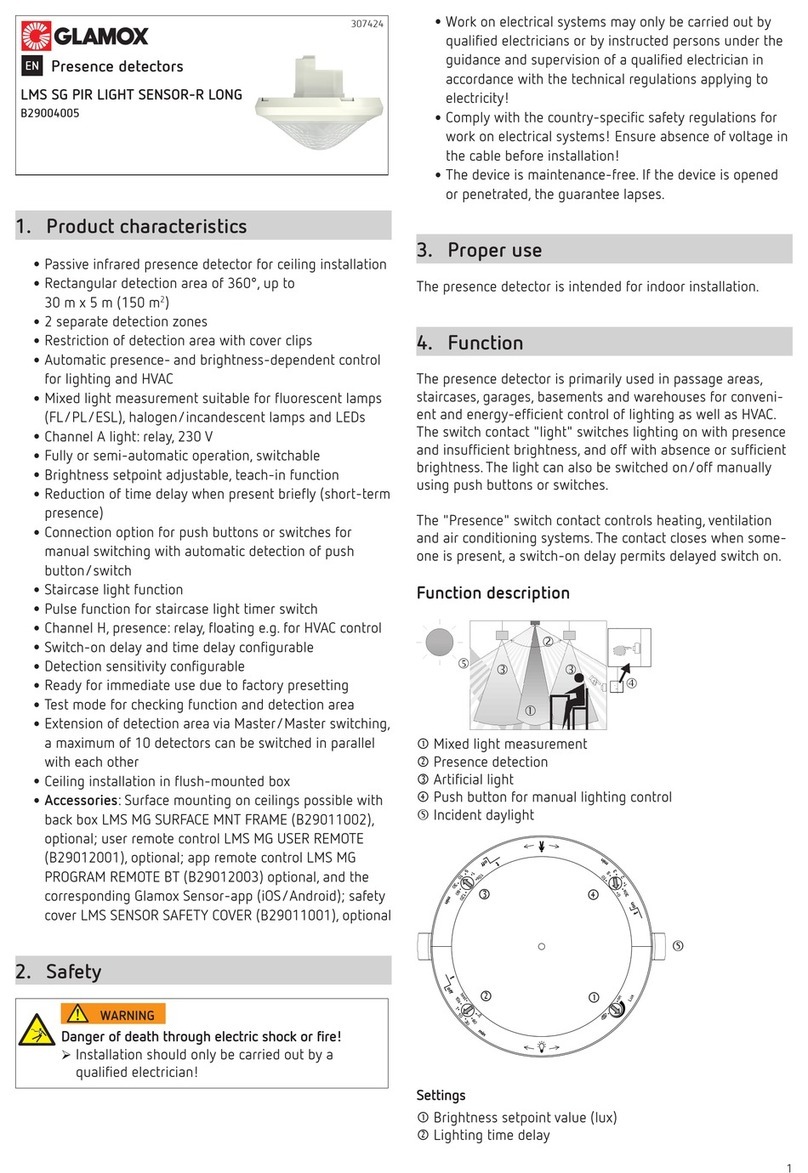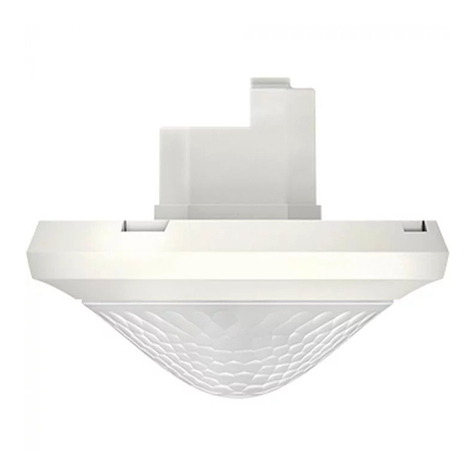
2
Constant light control
Constant light control compensates for variations in daylight
by controlling the lighting. The overall brightness will be kept
constant at the desired brightness level. The lighting is swit-
ched on with the switch-on dimming value and controlled so
that it reaches the set brightness setpoint value. Depending
on „school“ or „ofce“ conguration type, the presence detec-
tor behaves differently after manual dimming via button:
•„School“ conguration type for applications in classrooms
and meeting rooms:
Manual dimming deactivates constant light control.
Lighting remains at dimmed level when room is occupied
(no brightness inuence).
Switching off and on returns to standard operation.
•„Ofce“ conguration type for applications in small and
large ofces:
Constant light control remains active temporarily after
manual dimming to the current brightness value as the new
brightness setpoint value.
The new brightness setpoint value only applies if the room
is occupied.
After the lighting time delay expires, the originally set
brightness setpoint value is restored.
Switching operation
Switching response is controlled by presence and brightness.
The channel light switches on in darkness and if presence
is detected. The light switches off when there is sufcient
brightness or once the room is vacated after the set lighting
time delay. The light is switched on with the switch-on dim-
ming value. By using the button, the intensity of articial light
can be changed for the duration of the presence. Following
override using the button, the light stays on for at least 30
min. The light is forced off after a preset time delay if the
room was (previously) vacated.
Standby (orientation light)
The standby function acts as an orientation light. After the
lighting time delay expires, the lighting is set to the standby
dimming value (1 – 25%) of the lamp output. The standby
time can be set to between 0 s and 60 min or permanently.
The lighting is switched off if the brightness level in the room
exceeds the brightness setpoint value. The lighting automati-
cally returns to the standby brightness if the room brightness
falls below the brightness setpoint value. When the room
is entered again, the detector returns to the programmed
brightness setpoint value, either automatically (fully automa-
tic device) or after the button is operated (semi-automatic
device).
Lighting time delay
The minimum time delay (10 s – 60 min) is adjustable. It
adjusts automatically to the user‘s behaviour and can incre-
ase to 30 minutes or drop back to the set minimum time.
With settings ≤ 2 min or ≥ 30 min, the time delay remains
unchanged at the set value. If someone goes into an unoccu-
pied room only briey and leaves it within 30 seconds, then
the lighting will be switched off prematurely after 2 minutes
(short-term presence).
Push button control
The lighting can be manually switched or dimmed at any time
at the push of a button. A short press of the button switches
the light on or off, a longer press of the button dims the ligh-
ting up or down. The dimming direction changes each time
the button is pressed. If the lighting is switched off manually,
the lighting will stay off as long as the room is occupied. The
lighting switches on again automatically after the time delay
has expired. Please pay attention to the differing behaviour of
the constant light control and the switching operation, which
is described in the corresponding chapter.
Fully or semi-automatic device
Lighting control via the presence detector operates fully
automatically for increased comfort or semi-automatically for
greater energy savings. The lighting switches on and off auto-
matically as a “fully automatic device”. As a “semi-automatic
device”, the lighting must always be switched on manually.
The lighting is switched off automatically.
Exceptionally easy configuration of the energy-saving beha-
viour
By using the selection “eco” for optimal switching behaviour
or “eco plus” for maximum energy savings, users can adjust
the presence detector to their needs.
5. Detection area
The circular detection area of theRonda P presence detector
covers a large detection area, and permits a complete room
coverage with many applications. Note that seated and wal-
king persons are detected in different areas. The recommen-
ded installation height is 2 m – 6 m. As installation height
increases, the sensitivity of the presence detector decreases.
Walking motions are necessary from installation heights of
3.5 m, and the detection areas of several detectors should
overlap in the marginal zones. The detection range is reduced
as the temperature increases.
Seated persons:
The presence detector reacts very sensitively to the slightest
movements. The information refers to table height (approx.
0.80 m).
S
t
r
s
Value range (Glamox Sensor-app)
Installation
height (A)
Moving persons
Across (t)
Moving persons
Frontal (r)
Seated persons
(s)
2.0 m 380 m2Ø 22 m 28 m2Ø 6 m 20 m2Ø 5 m
2.5 m 415 m2Ø 23 m 38 m2Ø 7 m 28 m2Ø 6 m
3.0 m 452 m2Ø 24 m 50 m2Ø 8 m 38 m2Ø 7 m
3.5 m 452 m2Ø 24 m 50 m2Ø 8 m 38 m2Ø 7 m
4.0 m 452 m2Ø 24 m 50 m2Ø 8 m – –
5.0 m 452 m2Ø 24 m 50 m2Ø 8 m – –
6.0 m 452 m2Ø 24 m 50 m2Ø 8 m – –
10.0 m 491 m2Ø 25 m 50 m2Ø 8 m – –
All gures are guidance values.





























